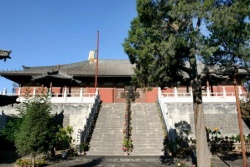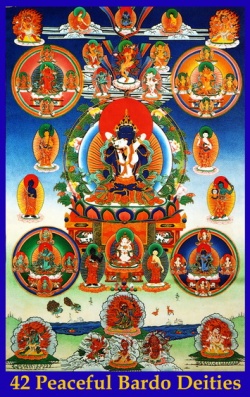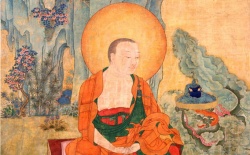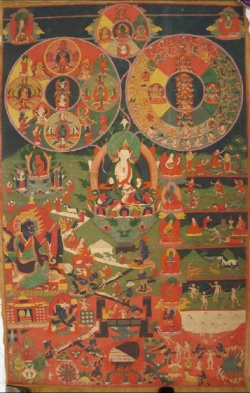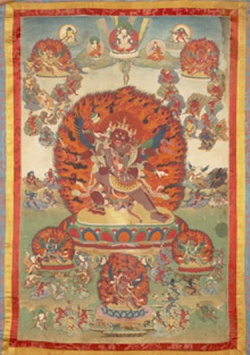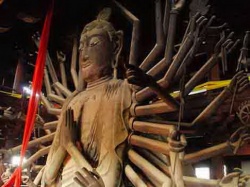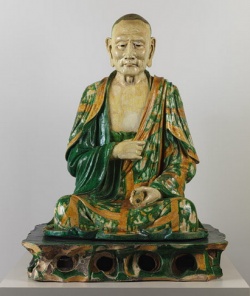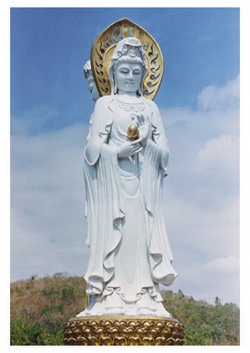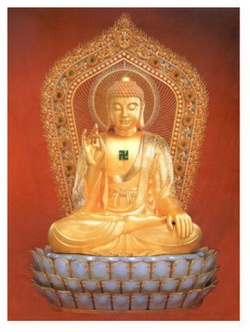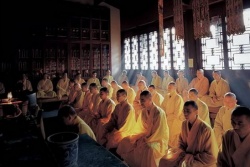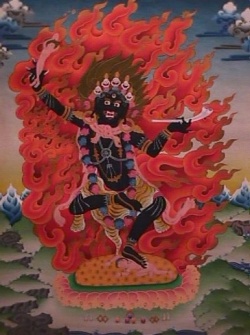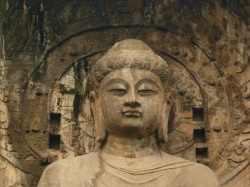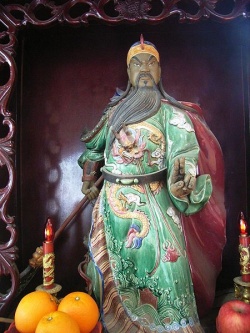The Nine Bardos of the Aro gTér by Ngak’chang Rinpoche
‘Instantaneous ordinariness’ is the fruit of the gYo-wa bardo. Instantaneous ordinariness is the moment when continuity is destroyed. As soon as continuity is destroyed, continuity appears again as the continuous moment of ‘Great Time’. One senses continuity again, but ‘that which is continuous’ is empty. One arrives at the non-dual point of realising the one taste of continuity and discontinuity. This is the essence of the tha-mal-gyi-shé-pa bardo: simply noticing death – and being born as the next moment.
With Vajrayana Teachings, as distinct from Sutrayana, one must be aware that there is a lineage. Vajrayana teachings have an origin – they are not generic information. One cannot receive teachings from a ‘generalised source’, and neither can one give teachings unless they come from a specific source and one has been given authority to teach from the lineage holder. One cannot speak of Tantra or Dzogchen as if the teachings of Padmasambhava & Yeshé Tsogyel were ‘public domain information’ which can be acquired merely from reading books. We now see an increasing number of New Age approaches to Buddhism, and, although sometimes well intentioned, these mix & match syncretic interpretations of Vajrayana are actually quite harmful. I do not usually commence teaching in this manner, but recently I have become aware that a plethora of erroneous notions are being purveyed – ideas which compare Vajrayana practices with positive thinking, affirmations, self-development, and a number of other concepts which are directly antithetical to Buddhism. In this context we can be heartily appreciative of Chögyam Trungpa Rinpoche for coining the term ‘spiritual materialism’. Because of him we can identify this insidious trend and root it out of our own practice.
What we shall discuss today has nothing to do with affirmations, or with winning friends & influencing people. We are not concerning ourselves with the spiritual materialism of ‘do what you feel’ and ‘follow your own inner guru’. We are Vajrayana practitioners and can have pride in our stubborn simplicity. Not pride in the usual sense of the word, but in the sense of cheerful confidence. We do not have to be seduced by ‘titillating tantrifications’ or ‘democratised dzogchenisms’.
We are going to discuss the teachings of the Nine Bardos. Their origin lies in the gTérmas of Khyungchen Aro Lingma – the Lady of Knowledge of the sphere in which the Great Garuda tastes the primordial ‘A’. That is the meaning of Khyungchen Aro Lingma. Aro Lingma realised a body of Pure Vision gTérmas directly from Yeshé Tsogyel in the earlier part of this century, and this makes the cycle of teachings unique.
The Aro gTér is a cycle of teachings which present everything from the point of view of Dzogchen. So whether they are teachings of Sutra or Tantra, they are all presented in the language of Dzogchen. A teaching such as the Nine Bardos is therefore expressed in non-symbolic language. The Bardo Thödröl, as it is usually taught from the gTérmas of Karma Lingpa, involves the 42 peaceful, 58 wrathful awareness-beings. In the bardo teachings of Aro Lingma, however, the practice is one of experiencing the thig-lés, which gives it much in common with to-gal. We’re not particularly going to go into that here because that would require a long retreat. We’re going to be looking at the aspects of the Nine Bardos which deal with integration at the level of everyday life.
Each system of bardos begins in a different place. In the Six Bardos we begin with the kye-né bardo, the bardo of birth; and then we go through the mi-lam bardo (the bardo of dreams); the samten bardo (bardo of meditation); the chhi-kha’i bardo (the bardo of death); the chö-nyid bardo (the bardo of dharmata or clear-light experience).
In the Nine Bardos we have a different orientation. We don’t begin with birth, but with death. This is purely an organisational arrangement with regard to discussing the teachings, but it is quite important. We start with the chhi-kha’i bardo. We then go to through the chö-nyid bardo. But here, in the Aro gTér, the chö-nyid bardo, or the bardo of dharmata, is separated into two: chö-nyid bardo is the first; and the second is nang-wa bardo (the bardo of vision). The chö-nyid bardo is split in this way because the bardo of vision (the nang-wa bardo) is the one in which one experiences the thig-lés.
When people in the West first discovered the Bardo Thödröl as a book, they had the idea that these visions were actually what you saw when you died: you saw the 100 awareness-beings of the bardo. This caused confusion for people because other cultures had very different descriptions of what might be seen in the death state. People tried to compare the teachings on the after-death state from different religions and got quite bewildered with their attempts to make everything fit together. They thought the Bardo Thödröl described a fixed ‘reality’ which would be there for everyone. But actually the only people who see the peaceful and wrathful awareness-beings are those yogis & yoginis who have practised them in their lives.
The 100 awareness-beings of the bardo are a method. It is crucial to understand this. Many people have no concept that Buddhism is almost 100% method. We hail from cultures where our religions speak of ‘truth’ ‘the three religions of the book’: Judaism, [[Wikipedia:Christianity|Christianity]], & Islam. But ‘truth’, and how it is conceived, is one of the major obstacles to the understanding of Buddhism because Buddhism doesn’t deal in ‘truth’. It deals in method. Truth is what is discovered through method. There’s the method and there’s emptiness. Truth is not really discussed as ‘the truth’, even in terms of describing reality, because even the description of ‘truth’ is a method of pointing at truth.
So let us now explore the idea of Tantra and how that functions in this sense. With Tantra we move from the idea that there is nothing there to the idea that whatever is there is simply there, in the moment it arises. We start to deal with form. Sutra doesn’t deal with form apart from the idea of letting go of form; and working through the ideal of compassion which is the practice of form. With Tantra we are integrating emptiness & form. With Tantra the whole teaching is oriented toward form – empty form. This is important to understand, from the point of view of the Nine Bardos, where the focus evolves around the gestalt of ‘whatever form is there is there in the moment’. I actually can have the vilified ‘atman’ but only in the moment. And then, in the next moment, it’s a different ‘atman’. If I want to extend the momentary atman from moment to moment, then there is no atman – no self, no soul. However, if I do not attempt to extend this momentary atman, then it’s miraculously there in the momentless moment. So it is not that it is either there or not-there. It is there only in the moment. This is a characteristic of Tantra which differentiates its ethos from that of Sutra.
In the teaching of the Nine Bardos, we begin with the chhi-kha’i bardo (the bardo of death); then the chö-nyid bardo; and then the nang-wa bardo (the bardo of vision). In the nang-wa bardo there is a particular practice of the thig-lés. This is also a practice in which one can engage on behalf of other beings. Maybe I will go into this at some other time – but, as I said, a long retreat is required. After the nang-wa bardo is the kye-né bardo (the bardo of birth); the mi-lam bardo; the samten bardo just as in the Six Bardos. The final two bardos, which constitute the nine, are called the gYo-wa bardo and the tha-shé bardo. ‘gYo-wa’ means ‘movement’. This is the same gYo-wa as the gYo-wa in the teaching of the Four Naljors. Tha-shé is a contraction of tha-mal-gyi-shé-pa. Tha-mal-gyi-shé-pa means ‘instantaneous ordinariness’. These are the two bardos we shall discuss today.
In English the Bardo Thödröl was called The Tibetan Book of the Dead. It was given this title because there was an Egyptian Book of the Dead. It was an unfortunate title; and it stuck like the term ‘Tibetan Buddhism’ stuck, because no one can think of anything better to call it. But people who live in Bhutan don’t think of it as Tibetan Buddhism. It would be like saying ‘English [[Wikipedia:Christianity|Christianity]]’ [laughs]. The title Tibetan Book of the Dead has given the impression that it is a teaching concerned purely with the aftermath of physical death. It certainly does concern physical death, but it also concerns birth. It could actually be called The Tibetan Book of Birth & Death, The Tibetan Book of Life, or The Tibetan Book of Existence & Non-existence. Trungpa Rinpoche once referred to it as The Tibetan Book of Space. A way of speaking has evolved recently in the West, in which people speak of these Vajrayana teachings in terms of ‘life & death’. This is a singularly odd pairing of terms from a Buddhist point of view – as if there were a Bardo Thödröl of Life & Death. From a Buddhist perspective we cannot polarise life & death in that way without buying into a paradigm in which death only occurs once in every life. It is extremely important to Khandro Déchen and myself that we undermine this type of spiritual materialism in those who are seriously interested in the Buddhist teachings.
If you want to come to terms with your physical death it’s important to understand that you cannot do this through doing hospice work as a volunteer, or working in a mortuary. People have this idea that you can come to an understanding of your own physical death in this way. This is not true. Maybe you can get used to the fact that people die, especially if you’re very afraid of death; and if you have locked yourself off from it by never considering hospitals, or never considering the fact that people are getting older. But even if you do look at these issues, you can easily end up in exactly the same position of denial. One can delude oneself in thinking that one has come to terms of death. This is the reason we exist in samsara anyway – we’re extremely tricky! [laughs] If we weren’t extremely clever, we wouldn’t be ensnaring ourselves in samsara. We can be outrageously clever about looking at corpses: ‘No pulse, no breath…’ then something clicks off in the mind. A silent statement is made: ‘This has got nothing to do with me’. So getting used to corpses doesn’t make much difference, really. The person who shuts out corpses can be exactly the same as somebody who looks at them every day, in terms of: ‘This has nothing to do with me… People die, yes, I know that. But it’s just that I’m a person for whom that fact has no real application; even though I actually have contact with ‘the dying’ and ‘the dead’.’ It’s always ‘the’, isn’t it… ‘the dying’ rarely do we hear, ‘people who are close to death’. One doesn’t really know if one is in denial or not like maybe I don’t really know if I’m doing samsara or not [laughs]. If I actually knew I was doing samsara, then [pause] maybe [pause] I might get suspicious of it.
One of the important things about the teaching of either the six or the nine bardos is the word ‘bardo’. Etymologically, it breaks down into ‘bar’, which means some kind of a movement or flow, like a stream; and ‘do’ which means some kind of an island or rock in the stream. There is an area amidst movement; that is the idea here. It doesn’t merely apply to the period after you’re physically dead although everyone says: ‘When you’re in the bardo’ as if we weren’t in it now [laughs]. ‘In the bardo’ like ‘in the dharma’ like ‘in the Navy’ [laughs]. So [pause] bardo has some meaning similar to gap, gestalt, time frame, or ‘pool of temporal space’.
In order to have some apprehension of what death is, one has to die. You cannot get used to anything without ‘doing’ that ‘thing’. ‘Doing death’ once every physical lifetime is not anywhere near frequent enough [laughs]. We must die as often as possible. There is nothing which divides the experience of death, at this level, from anything else that we do. If we die often enough, we will get used to it. So… this has to be applied in some way – we have to ‘do death’ if we want to get used to it. To ‘do death’ enough, we have to discover the moment of death every day.
The most obvious way of dying every day is simply through falling asleep every night – but, falling asleep in a slightly different manner. We begin here by looking at the practice of the mi-lam bardo. This is the closest and most overt form of bardo practice in our lives. If we practise dream-yoga we prepare for sleep by entering into a certain posture. There is also a certain visualisation which utilises one of the three syllables of Aro Lingma either
the short blue ’a
the white A
or the long red A’a’a
We will look at this practice of mi-lam here, because these practices are interconnected. It is crucial to realise this. The practice of mi-lam is based on the fact that when we go to sleep, the process mirrors the process of physical death – apart from the dissolution of space into itself. With physical death the psycho-physical elements dissolve into each other and disappear into primal emptiness. Earth dissolves into water. Water dissolves into fire. Fire dissolves into air. Air dissolves into space and space dissolves into itself. Then we enter into the chö-nyid bardo in which the son & mother clear lights are united. In the sleeping bardo one only experiences the ‘son light’ but in the bardo of death, chö-ku & chö-ying dissolve into the ground of chö-nyid.
The sleep equivalent of the nang-wa bardo is the phase of dream. The sleep equivalent of the kyé-né bardo is where we regain ordinary waking consciousness. This is a complete process, and one can experience death through practising within these bardos. One can experience death through being aware of the elemental dissolutions. One can experience death by entering into the dimension of ‘son clear light’. One can also experience it by retreating from the ‘son clear light’ into the bardo of dream. One can then ‘die’ from the bardo of dream into waking consciousness. It is important here to understand that one has to experience dying like this with complete presence. What we generally prefer is to be awake one moment, and asleep the next. We are reluctant about retaining presence through the process, because we would have to watch ourselves disintegrating. That process is very uncomfortable in terms of referentiality. We do not like to watch ourselves disintegrating. We need to acknowledge that. It is crucial to understand the ‘comfort factor’ in terms of loss of presence, and to spend around about five minutes in the process of conscious-to-unconscious if we are to avoid obliviating. If the falling asleep process happens too quickly we merely lose presence.
Most people will have heard of the Naro Chö-drug, the Six Yogas of Naropa; or the Nigu Chö-drug, the Six Yogas of Niguma. You will find that these practices are overlapping and interwoven within the practice of the Nine Bardos. In the Aro gTér, mi-lam is linked to the Nigu Chö-drug, and is compounded in a manner which ties together the practices of mi-lam, ’ö-sel (clear-light), & gyü-lü (illusory body). Usually these are spoken of as three separate practices within the Nigu Chö-drug, but in the Aro gTér they are combined within the bardo practice of the mi-lam bardo.
Q Does the kyé-né bardo refer specifically to the period of time that one spends in the womb?
R Yes… and in the bardo before that. It’s that entire phase of taking form. And then if you have realisation in the kye-né bardo, it’s called ‘a womb with a view’ [laughs]. Sorry about that.
Q Is existence also one of the Six Bardos?
R Yes. That is called the srid-pa’i bardo. The sequence is: kye-né, srid-pa’i, mi-lam, samten, chhi-kha’i, chö-nyid, nang-wa and then kyé-né again, and so forth. These Nine Bardos are more or less like the Six Bardos, but there are three extra. One of these is created out of the chö-nyid bardo being divided into two. The first is chö-nyid bardo experiencing the clear light. The second is the nang-wa bardo the section with the experience of the thig-lés. This nang-wa bardo section has two attributes. The first deals with the thig-lés as a method of evolving the dimension of dream experience. This is part of to-gal ngöndro within the Aro gTér. The second attribute deals with helping people who have died.
Q As a meditation practice?
R Yes. This is a non-liturgical practice. It’s also a non-symbolic practice in terms of the fact that yidams are not employed.
Q So it’s simply the forms of the thig-lés themselves?
R Yes… or rather their essential keys are evoked through symbolic contact. The field of energy which is known as thig-lé is evoked through sel-tong clarity-emptiness.
Q Usually the bardo system is given in a certain order from kye-né bardo, and I was wondering if there was a special reason for beginning with death?
R The Aro gTér system of the Nine Bardos starts with death, rather than starting with birth because, within this system, the pervasive understanding of ‘death within physical life’ is the key to all the other bardos.
Q So it starts from the position of the chhi-kha’i bardo; then the chö-nyid bardo; then nang-wa bardo, the bardo of vision; then the kye-né bardo, the srid-pa’i bardo; the mi-lam bardo, samten bardo; and…
R Then the gYo-wa bardo. gYo-wa means the bardo of movement, or the bardo of change, ‘the bardo of the changing moment’. The ninth bardo is the tha-mal-gyi-shé-pa bardo, which is the bardo of ‘instantaneous ordinariness’. We abbreviate ‘tha-mal-gyi-shé-pa bardo’ to ‘tha-shé bardo’. This was the common contraction of that word.
As I said earlier, the word ‘bardo’ means ‘space’ or ‘gap’; some kind of point within a field of movement. Bardo is a ‘recognisable area’ there is chaos, and then there is an understandable aspect. The understandable aspect is ‘do’ that which does not appear to be moving in the moment. We can call this a ‘gap’, a ‘space’, or a ‘pool of time’.
When we look at the other bardos, we can see that they concern specific periods of time when something is happening. Either one is coming into birth, one is dying… [laughs] A German gentleman once asked me if I knew a humorous German definition of life… he said it was that life was just ‘one damned thing after another’. [pause] Obviously German humour is different from West Coast humour [general laughter]. Maybe that’s some other form of bardo [laughs].
Meditation is also known as a bardo – not simply the samten bardo of meditative stability, but the regular session when one sits and then one stops sitting. This is also bardo. Bardo is a space where whatever is contained within that space, has a particular type of flavour. The mi-lam bardo, the bardo of dreams, has the flavour of one’s dreams. They could be nightmares. They could be erotic…
Q Or erotic nightmares? R [laughs] I’m sorry. The srid-pa’i bardo has the quality of one’s life circumstances – one’s human existence, physical, corporeal. So gYo-wa bardo, then, is a way of developing the texture of the srid-pa’i bardo into enormously rich momentary detail. There is a certain kind of a gYo-wa bardo retreat that you might like to try. It is interesting that we have technological facilities which make this practice a lot easier than it was in Tibet. In Tibet they had to use memory and physical objects for this retreat; but here we can use photographs. It’s very useful to have photographs for this retreat, because one looks back on one’s past. This is a very interesting retreat to attempt: you look at a photograph of yourself and you ask: ‘Right, who is that? Is that me? Yes… I know that’s me. I know that at that time I was doing certain things… I was at school. Or maybe I was at college. I was wherever I was. I was in this relationship. I had clothes which looked like this. I maybe remember some favourite possessions. I can remember all these things… but can I remember what it was actually like to be the owner of these things? Can I be that person again even for a moment?’ In the Tibetan tradition one would look at objects, if there was anything left over from one’s childhood some toy with which one played. One would pick it up and ask: ‘Can I be that child playing with that object?’ And you discover that you can’t. Maybe you can get some kind of feeling around it; but whatever that experience is, you are an adult remembering that experience. What you find is that you fail – it is not actually possible to be that child again. That child is dead. Within the gYo-wa bardo retreat we review our lives and we can ask: ‘How early can I remember?’
Obviously, if you see a picture of a baby you look at it and say: ‘Well, I can’t relate with that child at all anymore’. But then after reviewing a series of slightly older infants you arrive at a certain age which you seem to be able to recall. Then you might say: ‘Yes. I can remember this now. I remember some events’. So you look at those events. If you have a series of photographs, it’s very useful: you go from one to another. You follow them through one by one in chronological order trying to relate, and continually failing to relate.
Q You’d think that the closer you came to the present, the more you’d be able to relate but you find that that’s not true?
R That’s right. And that is eerie. This retreat is about breaking up the continuity of one’s existence.
Q So one has to realise that one is not continuous?
R Yes. One practises this by looking at one’s life, especially by looking at important events.
Q A great thing in the West is that most of us have been through a few relationships. That must be very useful for this retreat…
R Sure. I remember partners who left me [pretends to sob] ‘I didn’t want you to leave me.’
Q Right I thought that this person was very, very important to me.
R Yes, and I may have said to friends: ‘I’m totally bereft now; I will never find such a person again’. But then, a while later, I’m with somebody else and suddenly this person is not so important any more. And someone says: ‘Hey I thought you said that this was the only one in the world for you?’
Q That just so strange isn’t it… how one’s whole experience is coloured by what’s happening at the moment.
R Yes. This is the bardo of this relationship.
Q It ends, and then what? I’m in another one; and I look back, and I can’t relate to him anymore.
R That’s right. He’s gone… She’s gone… gone beyond: ga-té, ga-té, paramour ga-té, paramour sam ga-té bodhi svaha…
Q [laughs] So I now look at this previous lover I think: I used to admire this person, and now I see that this person is actually a little bit dim you know, this person doesn’t pick up on things very quickly… [laughs]
R Or maybe you think: ‘Whoa, what’s happening here? What was it about this person that was so special? This is a nice person sure. This person is still a friend – sure. I admire and respect this person – sure. But there was this electricity… where is that now? This person is now like my sister or brother! Maybe I see him or her once a week… Maybe we’re still good friends… but where did that enormous passion go?’ It’s not there. It’s vanished.
Q Our lives are full of these experiences, aren’t they.
R Yes… People we love, and then we no longer love. Things we liked that we no longer like…
Q Like, this is me in my first pair of bell-bottoms [laughs]. What do I think I look like now? At the time I thought these were so good… You know, the ones you open up and put extensions in?
R ‘Sails’ we used to call them in Britain. We used to cut up the sides of our Levis and we used to put sails in them… and we used to make them really wide. My brother and I had this great idea – I’m not sure if anyone else on the earth ever did this [laughs]. We got a pair of Levis each, and then we bought a third pair. We’d say to the shop keeper: ‘We want the biggest pair you have in stock, the widest waist and longest legs.’ We’d take them home and un-pick the third pair in order to cut them up and make enormous ‘sails’. We’d save up for ages to do this [laughs]. The bottoms of our Levis were wider than the waists. That was the thing then, for those who were sufficiently obsessed. And then you had to try to ride a bicycle with them, which meant wrapping them round and round your leg and tying bits of string round them so they didn’t get caught in the chain. The thing was that nobody else had them! Forty-two inch bottoms! [laughs] We could have sheltered a herd of yak in those Levis.
Q But you wouldn’t wear them now…
R [laughs] I guess you’re right. Fashion is great for this. People think that spiritual practice was easier in the East. That is romanticism. It’s actually not easier or more difficult anywhere simply ‘different’. It’s important to look at the advantages of the West which people don’t usually see as advantages. Fashion is a great advantage with this practice; especially if you go through it in an extreme manner.
Q You look at yourself and say, ‘Now I thought this was really stylish, I was proud of these…’
R … and now I’m here talking to a room full of people making a joke about them. Yes.
Q It’s fascinating that our perception can change so much. And it’s not like now I’ve seen the error of my ways, and I’d never wear anything I would laugh at in ten years again. So wherever I am… [interrupted]
R … there’s a subjective quality which has a whole gestalt of appreciation, and of meaning. This practice, then, is to look at one’s life, and to look at it in successively smaller sections of time. Obviously, as you come closer to the present, the periods of time which you can isolate get smaller, until you’re looking at yesterday. The quality of yesterday…
Q ‘… all my troubles seemed so far away, now it looks as though they’re here to stay…’
R But I don’t believe in yesterday [laughs].
Q Like I got up in the morning, I was in a bad mood, and I got this letter saying I’d gone over the limit on my credit card. Or a friend phoned me, and was irritable with me, and that was yesterday. And today I wake up, I’ve won some money. I got a nice letter. The weather is how I like it. Now I feel different.
R Then there’s ‘here’ where we are now. Previously there was ‘this morning’. Then there was the bardo of ‘the story of my brother and our Levis’ there was a feeling when that story was being told. Then there was the bardo of ‘lunch’. Now there’s the bardo of ‘here’.
In terms of the practice of everyday life, it’s valuable if you live in a city. People always think that the country is better for practice, but the city makes it very easy to have smaller and smaller bardos: I get into the car. I drive. I get out of the car. I get on to the train. I sit down. I come to this place. I get out. I walk to my job. I go in the door. I climb the stairs. I enter the elevator. Whatever I do… each segment can become smaller… until… one… is. … continually popping out of nothing. This is the nature of the practice of gYo-wa bardo. I have to appreciate the texture of each moment. I have to recognise what’s there in the moment. There’s being in here with these colours… When I talked about this in New York someone said: ‘Doesn’t that make you really disassociated?’ [laughs] But gYo-wa bardo doesn’t have that quality at all because one has to be totally, fully, exactly where one is. One has to actively appreciate in order to distinguish what is different. If I cannot distinguish what is different, I cannot distinguish increasingly smaller bardos: out there it was warmer; in here it’s cooler. The colours are different. The light is different. There’s a whole different sense of being ‘in here’. I have to appreciate that in order to distinguish it from ‘out there’. I notice the transition. You as an audience of apprentices maybe notice transitions in what is being expressed here. There were phases in which I was attempting to be amusing. There were phases in which I was apparently not attempting to amuse. You can have a constant unspoken question: ‘What is the difference between this moment and the last? How am I hearing this? What is this bardo of this moment?’
Q It’s sensing the change?
R Yes. That’s dead now. That’s gone. And now there’s this.
Q So this is why the Nine Bardos of Aro Lingma start with death?
R Sure. It doesn’t start with death because it’s a more morbid system [laughs]. It starts with death because this is the way we experience bardo within the stream of our physical lives.
Q By dying to the previous moment, and then: ‘Phhht! Different!’
R Exactly. Everything has to die in order to be born in the next moment and to experience it fully. One develops this quality of how everything keeps changing. How it’s a different moment every moment. A different pool of time. Obviously with this practice, one has to work at it gradually.
Q To look at larger periods, like ‘today’: how is today different?
R Yes. And then how was this morning different? Being in this restaurant. Being in this car trying to get back to Alameda, but Sky Tiger insists on attempting to drive there via the Mexican border [laughs]. This is a practice one has to work at over a period of months, in terms of making the fragments of life smaller. It has to be gradual… But that is not to say that one can’t just experience a moment anyway.
Q But in general we’re trying to live this practice?
R That’s right. We simply develop an appreciation of any space in which we find ourselves. We become sensitive to the moment of change. We recognise the passing moment: ‘That’s gone. That’s dead. Now this’. As soon as we realise that that past moment is dead, we’re on the fabulous brink of the next moment asking without asking: ‘How is this different?’
Q So not in a kind of analytical way?
R No, in a way that is simply open to what is there. The restroom. Now I’m out of there. I’m somewhere else. I’m in the kitchen. I’m in the bedroom. There’s a whole different area in each moment as different as car, airport, æroplane, different country. The bedroom is a different country. The bathroom is a different country. This part of the bedroom. Being in bed. Every place is different.
Q And that can simply increase all the time?
R That’s right. You see, every practice within Buddhism is really the practice of emptiness & form. Sutra, Tantra, Dzogchen it’s always emptiness & form. There are so many different ways of working with emptiness & form. When one practises tong-len, for example. Tong-len is the exchange of self & other: taking on all of somebody’s problems mentally and giving out all of your advantages. This is an emptiness & form practice. In terms of helping others, not putting oneself first this is emptiness & form in terms of self & other.
Q ‘Self’ is emptiness and ‘other’ is form.
R That’s right.
Q So this is a way of approaching non-duality?
R Sure. This is a way which is typical of the practice of Sutra. One dissolves the boundary between self & other, in order to realise inter-connectedness. This is one approach. When we look at the Four Naljors, the approach is nè-pa & gYo-wa. The arising namthog and the empty state and the question: ‘What is the same in these two experiences?’ This is based on meditative experience in terms of arising namthogs. But here, with the practice of the bardos, we’re looking at another aspect of emptiness & form: continuity & discontinuity. Continuity is form. Discontinuity is emptiness. We are approaching non-duality through increasing the quality of discontinuity. We’re making life totally discontinuous. There’s escalating disjuncture. Disjuncture every second. The moment gets smaller and smaller and smaller, until all sense of continuity collapses into itself. And this point, at which all continuity is destroyed, is called tha-shé bardo, or tha-mal-gyi-shé-pa bardo. Tha-mal-gyi-shé-pa bardo is actually the fruit of the gYo-wa bardo. As I said, tha-ma-gyi-shé-pa means ‘instantaneous ordinariness’. As soon as continuity is destroyed, it appears again as the continuous moment of ‘Great Time’. One is continuous again, but that which is continuous is empty. One arrives at the non-dual point of realising the one taste of continuity & discontinuity. This is the essence of the tha-mal-gyi-shé-pa bardo: simply noticing death - and being in the next moment. With the practice of tha-shé bardo, one doesn’t have to do anything at all… apart from live as one would otherwise live. It’s a practice of total integration. There’s no aspect of life with which one has to ‘do’ anything. Every moment of life is practice. There is no time when one is not practising [laughs] apart from when you’re not practising that is, if you’re no longer aware of disjuncture. It is a practice of recognising disjuncture, until disjuncture becomes so rapid that it disappears into itself and becomes continuity.
Q But it’s a discontinuous continuity?
R That’s right or a condition in which continuity & discontinuity have no meaning anymore. Bardo has become so small that it’s unreliable as a reference point.
Q So it dissolves…
R Yes.
Q But then we start doing it again!
R Yes. One achieves success at this, one glimpses Great Time, and then it disappears because one takes refuge in small time again.
Q We’re not going for emptiness here, are we?
R No, we’re going for form: the form of the next moment.
Q So death is behind you?
R Yes, exactly. This is a different approach. Death is the starting point.
Q That’s why it starts with the chhi-kha’i bardo with death.
R That’s right. Yes. Then you move into form but from death. Death is essential, without the initial death, birth cannot happen.
Q So you move directly into birth from death.
R Yes, that is the style of the gYo-wa bardo.
Q But could you start from birth also?
R Yes, that’s why the system of the Six Bardos starts from birth. But whether you start from birth or death it would be the same. There is actually no difference.
Q Rinpoche, I heard that you and Khandro Déchen advise people who don’t have a great deal of time for formal practice, that the nine bardos or particularly the gYo-wa bardo can be one’s main practice.
R Yes, certainly. Khandro Déchen in particular has often given apprentices that advice. It is a valuable practice for mothers, I should point out.
Q That’s a great practice of emptiness in itself isn’t it.
R Certainly. But in terms of the gYo-wa bardo it’s a practice in which emptiness is retrospective. Emptiness is continually shifted to the previous moment. The previous moment is continually blinking out of existence. Dead. Dead. Dead dead dead. In silent sitting, usually one is moving towards the emptiness; but here the emptiness is always just behind me. I’m appreciating the form of the next moment with vivid freshness as it comes into being. And then as soon as it’s there it also dies into the next moment.
Q But I have to be empty to appreciate the form that’s just arisen.
R Yes it’s the form which has only just arisen. That then becomes extraordinarily rich, clear, vivid, elaborate, yet spacious.
Q That sounds like the five elements…
R That’s right. The five elements: rich, clear, vivid, elaborate, & spacious earth, water, fire, air, & space.
Q So the gYo-wa bardo is like a reversal of the usual procedure in shi-nè where we’re going for emptiness?
R Exactly. That’s really quite fascinating isn’t it… fascinating that it’s possible… Emptiness through going for form through turning the previous moment into emptiness. Since form is emptiness and emptiness is form this is inevitable.
Q We can’t actually avoid that then, can we? I mean, a practice like this really inverts our systems and says: ‘Okay, you’re frightened of emptiness? Okay, so it’s behind you!’
R But you’ve got a new form, and the new form is empty.
Q That’s kind of a trick, really, isn’t it…
R Sure. Vajrayana is full of trickery of that sort.
Q Because going toward form is what we’re used to?
R Yes, that’s why the emphasis here is on appreciation of the next form. But if we really appreciate the next form, the previous form has to die. That is the principle. So… death is only something you can come to terms with… if you die. You have to have experience of dying in order to come to terms with death.
Q Right… and, as you said, hanging out in the local mortuary or hospice won’t do that.
R Quite. You have to become the local hospice in yourself. You have to become the mortuary. The field of your perceptions has to become the mortuary of your past experience. Your past experience just keeps dying.
Q So… if one were actually able to live in that moment of continual arising, then death would no longer be a big problem?
R Exactly because one realises that one is continually dying. It is then that we realise that continuity is an illusion of our own creation.
Q So what we’re doing is cutting away at this idea of continuity all the time.
R Yes and if we succeed in that, then death is not a problem; especially if we also practise mi-lam. With mi-lam we will have had the experience of the dissolution of concept-consciousness through the elements. The two practices dovetail perfectly.
Q And then there’s also gyü-lü which is a similar practice, isn’t it? Could you say something about that?
R Yes. I didn’t go into that this morning. With gyü-lü we wake up and sound one of the syllables of mi-lam: either the short blue ’a, the white A, or the long red A’a’a. The practice after sounding the mi-lam syllable is simply to get up and live the first half-hour or hour of your life as if it were a dream. One consciously regards everything as unreal. This is called gyü-lü. And this is another process of emptiness & form in terms of the one taste: it is the one taste of dreams & waking reality. ‘Dream state’ and ‘waking state’ become a seamless continuum. The consciousness which is dreams and the consciousness which is ‘awake’ have the same taste. One experiences non-duality through the integration of dream state and waking state. This is very much the style of teaching which is typical of everything within the Aro gTér. It’s the experience of the one taste of two elements which represent emptiness & form: continuity & discontinuity; dream state & waking state; nè-pa & gYo-wa. It’s always nyi-mèd, the two have one taste.
